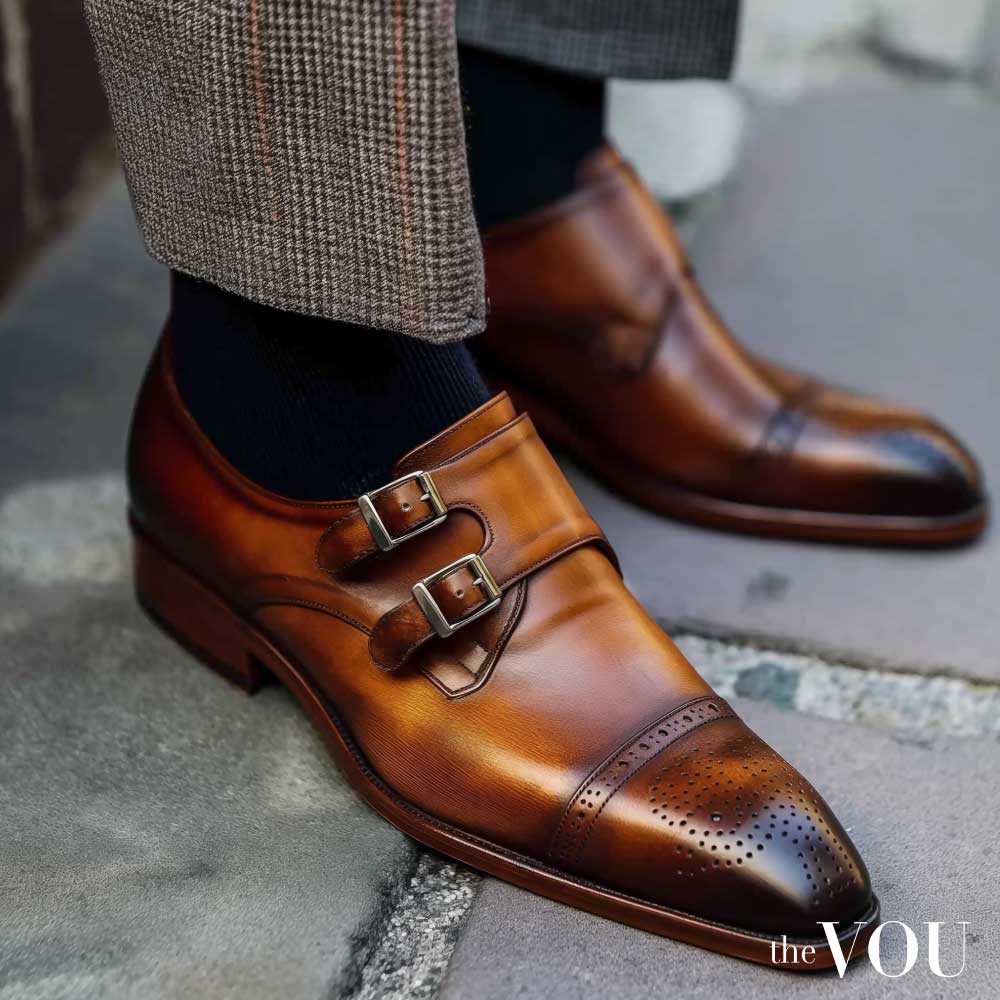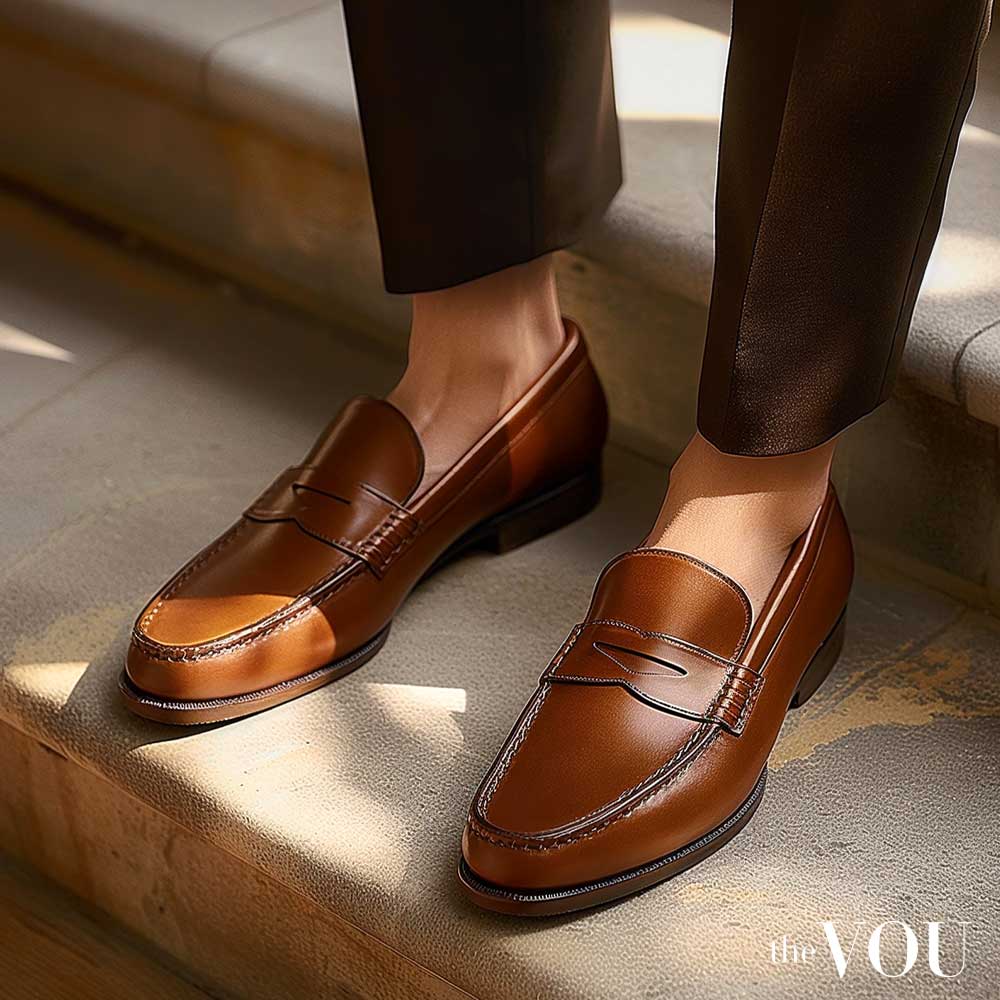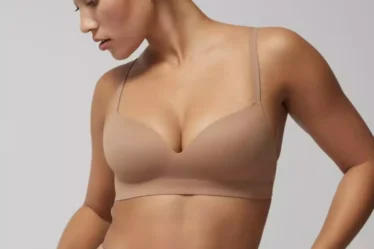
Business casual shoes are the critical link between formal attire and relaxed dressing, forming the cornerstone of a refined office fashion style.
In this styling guide, we’ll cover the must-know shoe styles essential to embodying the elusive balance of the business casual dress code.
Prepare to discover the subtle nuances distinguishing Oxfords from Derby shoes and how choosing the correct colour, texture, and details is critical to creating a relaxed yet professional image.
Business Casual Shoe – Main Styles
| Style | Characteristics | Formality |
|---|---|---|
| Oxford | Closed lacing system, often featuring brogue detailing | Moderate |
| Derby | Open lacing system, more casual than Oxford shoes | Moderate to casual |
| Monk Strap | Fastened with one or two buckles, no laces | Moderate to casual |
| Loafer | Slip-on design, often featuring a penny or tassel detail | Casual |
| Chelsea Boot | Ankle-high boot with elastic side panels, no laces | Moderate to casual |
| Chukka Boot | Low-ankle boot with a simple, unlined construction | Casual |
Oxford Shoe
While the Oxford shoe is regarded as a formal dress shoe by construction, it can be delicately incorporated into a business casual ensemble.
To strike the perfect balance, pay close attention to the details of your Oxfords, such as the choice of leather (suede or pebble grain being more casual than polished calfskin) and the presence of embellishments like wingtips, medallions, or broguing.
These subtle design elements will help downplay Oxford’s inherent formality, allowing it to integrate into your business casual wardrobe seamlessly.
Derby Shoe

With its open lacing system, the Derby shoe is a natural choice for the business casual dress code.
This style offers many options, from simple and streamlined to elaborately detailed.
Whether you prefer a plain-toe Derby or one adorned with brogue patterns, the key is to select a pair that strikes the right balance between smart and relaxed.
Monk Strap Shoe

For those who prefer the ease of a slip-on shoe, the monk strap is a refined and stylish alternative to the traditional laced dress shoe.
The monk strap’s absence of laces lends an air of elegant nonchalance, making it a versatile choice for business casual attire.
Experiment with single or double monk strap designs, various toe shapes, and levels of detailing to find the style that best complements your aesthetic.
Loafer

No discussion of business casual footwear would be complete without the venerable loafer.
Whether you opt for the timeless penny loafer or the more decorative tassel loafer, this slip-on style is a quintessential choice for a relaxed yet polished look.
Loafers are easy to slip on and off and exude an air of casual sophistication perfectly suited to the business casual dress code.
Chelsea Boot

An interesting addition to the business casual shoe repertoire is the Chelsea boot. Usually constructed with a minimalist design featuring a few panels, the Chelsea boot can create a streamlined, wholecut-like aesthetic without the formality of laces.
Depending on the level of embellishment, these business casual boots can be a versatile option for bridging the gap between smart and casual.
Chukka Boot
The Chukka boot is a soft, simple, low-ankle boot that falls at the more casual end of the business casual spectrum.
Essentially a Derby shoe with an extended ankle opening, the Chukka is a comfortable and adaptable choice worn with business casual ensembles and more casual weekend attire.
Business Casual Shoes – Colour and Texture
The colour and texture of your business casual shoes play a crucial role in achieving the perfect balance between formality and relaxation.
Understanding the nuances of different shades and materials will empower you to make informed choices when curating your professional footwear collection.
Black
As a general rule, black shoes should be avoided for most business casual scenarios.
The inherent formality of black footwear can disrupt the relaxed aesthetic you aim to cultivate.
An exception to this guideline would be black loafers, where the slip-on silhouette helps downplay the dark colour’s formality.
Oxblood and Burgundy
Rich, dark hues like oxblood and burgundy are ideal for business casual shoes.
The red and brown tones blend creates a sophisticated yet versatile colour that straddles the line between formal and casual.
Oxblood and burgundy leathers, like the iconic Cordovan variety, possess a natural shine that can add a touch of refinement without veering too far into formal territory.
Green
For the adventurous gentleman, incorporating a touch of green into your business casual shoe collection can be a compelling option.
A dark, earthy green, such as in a suede Oxford or a long-last Chukka boot, can provide a subtle contrast that elevates your ensemble without overwhelming it.
Brown
Brown shoes are a quintessential choice for business casual attire, as they bridge the gap between formality and relaxation.
Whether you opt for a deep, rich chocolate brown, a medium chestnut, or a lighter tan, this neutral hue’s versatility ensures that it will seamlessly integrate with the rest of your professional wardrobe.
Bright White
At the more casual end of the spectrum, bright white shoes should be avoided in business casual settings.
While white may evoke a sense of sophistication and wealth, it is ultimately too casual and sporty for the office environment.
Stick to more subdued shades when selecting your business casual footwear.
Business Casual Shoes Dos and Don’ts
To ensure you make the most informed choices when curating your business casual shoe collection, consider the following guidelines:
| Do | Don’t |
|---|---|
| Invest in high-quality leather shoes from reputable brands | Opt for cheap, poorly made footwear |
| Incorporate broguing, wingtips, or other decorative elements to add visual interest | Choose shoes with overly trendy or flashy design features |
| Experiment with muted, earthy colour palettes like browns, greens, and burgundies | Wear bright white or overly casual sneakers |
| Ensure a comfortable, well-fitted silhouette that complements your overall look | Sacrifice comfort for the sake of style |
| Pair your business casual shoes with tailored trousers, blazers, and knitwear | Wear your business casual shoes with overly casual or sporty attire |
3 Versatile Business Casual Outfit Ideas
To inspire your sartorial journey, our stylists have put together three impeccable outfit ideas designed to exemplify refinement and relaxation – outfits you’ll have to match with the right business casual shoes.
The Morning Meeting Ensemble
For an important morning meeting, pair a navy wool suit with a crisp white cotton shirt.
Accessorise with a burgundy silk knit tie and a classic leather belt. Complete the look with oxblood cap-toe Oxfords adorned with subtle wingtip detailing.
This refined ensemble strikes the perfect balance, commanding respect while maintaining an approachable, business-casual look.
The End-of-Week Casual Chic
As the workweek winds down, embrace a more relaxed vibe with straight-leg tan chinos, a light blue Oxford cloth button-down, and a soft, unstructured olive cotton-linen sport coat.
Anchor the outfit with a pair of burnished brown suede Chelsea boots, which lend an air of understated sophistication.
This stylish yet comfortable look is perfect for after-work drinks or a casual Friday in the office.
The Boardroom Minimalist
For important client meetings or board presentations, build your ensemble around a slim-fit charcoal grey wool suit.
Pair it with a crisp white spread-collar shirt and finish with sleek black monk-strap shoes.
Add subtle elegance with a rich cognac leather belt and a minimalist stainless steel watch.
This modern, pared-back aesthetic exudes an air of confident professionalism.
Business Casual Shoe Styling Tips
While the foundational business casual shoe styles are essential, incorporating more advanced styling techniques can help you elevate your professional look to new heights of sophistication.
Mastering the art of mixing textures, incorporating seasonal shades, and using your shoes to anchor your entire outfit can create a polished, intentional style.
Texture Play
Build a diverse business casual shoe collection that allows you to mix and match different textures.
Various leather finishes, from smooth to suede to pebble grain, enable you to create depth and contrast within your outfits.
For example, pair a sleek, polished leather Oxford one day with a soft suede Derby the next.
This textural interplay adds visual interest and prevents your look from appearing one-dimensional.
Seasonal Shades
As you update your wardrobe for the changing seasons, your business casual shoe collection should also evolve.
In the warmer months, wear lighter, more summery tones like tan, beige, or light grey.
As the weather cools, transition to richer, earthier hues such as burgundy, forest green, or deep brown.
Anchoring the Outfit
Your business casual shoes have the power to define your entire professional ensemble.
Rather than treating them as an afterthought, use your footwear as the starting point for building your look.
Let the shoes inform your choice of trousers, blazer, and accessories to create a harmonious, intentional style.
Choosing and Styling by Occasion and Season
Navigating the nuances of business casual dressing requires understanding how to select the appropriate footwear for any given situation.
Whether you’re attending a morning client meeting, participating in a team brainstorming session, or socialising at the end of the workweek, your choice of shoes can significantly impact the overall impression you convey.
Seasonal Considerations
When choosing business casual shoes, consider the changing seasons and how they may influence your selection.
In the warmer months, opt for more breathable, lighter-coloured options like suede Derbies or perforated leather loafers.
As the weather turns colder, transition to heartier materials like calfskin Oxfords or weatherproof Chelsea boots.
Workplace Versatility
For important client meetings or boardroom presentations, err on the side of slightly more formal footwear, such as brogued Oxfords or sleek monk straps.
These styles project an air of authority and professionalism.
On the other hand, for more casual in-office gatherings or end-of-week celebrations, you can afford to be more relaxed with your shoe choice, incorporating suede Chukkas or burnished leather loafers.
Occasion-Specific Styling
The specific occasion should also inform your business casual shoe selection.
For a morning meeting, pair your polished Oxfords with a tailored suit and crisp shirt to convey a sense of refined preparedness.
When attending an after-work social event, swap the suit for chinos and a sports coat, complementing the ensemble with sleek Chelsea boots or penny loafers to strike the right balance between smart and casual.
Accessories for Business Casual Shoe
While the foundation of a refined business casual wardrobe lies in the shoes themselves, strategic accessorising can take your look to new heights of sophistication.
By thoughtfully incorporating belts, socks, and other complementary elements, you can amplify the impact of your footwear and create a polished, cohesive ensemble.
Belts and Shoes
Ensuring your leather belt and shoes match colour and finish is a simple yet impactful way to pull your business casual look together.
A cognac leather belt with matching oxblood Oxfords, for example, creates a seamless, tailored appearance.
Experiment with different shades and textures to find the perfect belt-shoe pairings.
Socks
Your choice of socks can make a surprising difference in the overall sophistication of your business casual ensemble.
Opt for quality cotton or wool socks in complementary colours and patterns that add a touch of personality.
Avoid plain, boring black or white socks, which can appear too casual.
Accessory Styling Tips
Match your belt and shoes in both color and finish for a polished look.
Incorporate patterned or textured socks to add visual interest.
Experiment with accessories in seasonal shades to reflect the changing weather.
Use accessories to tie your entire outfit together for a harmonious, intentional style.
By leveraging the power of strategic accessorising, you can elevate your business casual shoe game and cultivate a professional image that commands attention.
Conclusion
Through this in-depth exploration of business casual shoe styles, colours, textures, and accessorising techniques, you are now equipped with the knowledge to curate a professional footwear collection that exudes refinement and versatility.
By investing in timeless silhouettes like Derbys, loafers, and Chelsea boots, and learning to harness the power of strategic accessorising, you will be able to seamlessly navigate the ever-evolving landscape of office attire.
Remember, your choice of business casual shoes has the ability to anchor and define your entire professional ensemble, so approach each selection with intentionality.
Whether preparing for an important client meeting, participating in a team brainstorming session, or winding down at the end of the workweek, having the right shoes at your disposal will instil you with the confidence to present your best self.
Embrace the art of business casual dressing, and let your footwear be the foundation upon which you build a polished, sophisticated professional image.
With this comprehensive guide as your sartorial compass, you are poised to elevate your office style to new heights of distinction.



